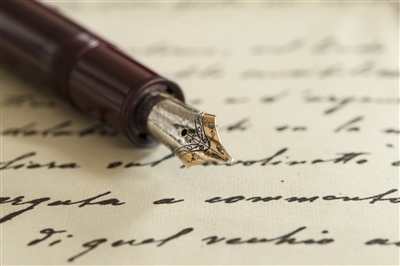Handwriting your study notes facilitates memory and understanding

When I was a schoolboy back in the late 1960`s each class contained no less than thirty five pupils, and we sat in pairs at wooden desks. These desks had a large hinged top, and lifting this heavy writing surface would reveal an archaeological treasure trove of past lessons: fragments of paper, disused text books, and fossilised sweets that some child had smuggled into class. At the front end of the desk was a recess in which a metal receptacle sat. This was filled with ink, and we would periodically dip our pens into the black liquid, nibs scratching away at our paper as the teacher delivered the lesson.
The nibs on our pens were metal, viciously sharp, and had to be frequently `tuned` so that they delivered anything even approaching a legible line. Because the pens themselves had no ink storage system, one was required to dip the nibs into the inkwell every few words. I can remember on one occasion having completed a page of writing that to my eyes looked tolerably well scripted, but when as I drew my pen back from the well it dripped black blobs all over my work!
Of course these kinds of practices must sound remarkably archaic to the modern pupil - the very idea of re-inking a pen probably sounds anachronistic to many students, writing equipment being such a disposable commodity these days. My children told me that during their time at university they would record their lectures, simply using the built in microphone on their laptops to capture the words of their teacher.
While I can understand the convenience of this, I do think something is lost when one passes over the opportunity to put words down on paper. When a student is compelled to write down the lesson, they are forced to assimilate the words, to absorb the sentiments of what is being taught. Even if they are only taking down dictation, and writing verbatim (as best they can) the words of their teacher, the very act of writing down the lesson will prove instructive. Perhaps this is because one cannot write casually or indifferently, at least not without producing work that is incoherent.
When I was a student at university I recall a number of lecturers who were rather verbose in their lessons. Perhaps they relished the sound of their own voice, but the lectures would often be of extremely lengthy duration - three hours or more, with the lecturer talking at an extremely rapid pace throughout. This was a time prior to there being any affordable or discreet recording devices. Perhaps a student could have mounted a reel to reel tape recorder on their table, but I daresay this would have drawn comment.
In order to capture as much as I could of the lecturer`s words, I would scribble down key parts of their lesson, confident that I could expand upon these pointers later, when I wrote up my notes back in my halls of residence. This method enabled me to listen and absorb the lesson, without focusing all my attention on attempting to transcribe the lecturer`s every word.
Once back in my room the lecture would still be fresh enough in my mind that I could, with the help of my notes, write up a good account of the lesson. I actually believe this method to have been extremely helpful, and of more didactic purpose than an audio recording making a perfect transcript of the lecturer`s words. With only a sparse set of notes, and my memory of the recent lesson, I was forced to both consult text books, and most importantly, put the lesson in my own words, as I made an account of the class.
Research conducted by the Norwegian Centre for Learning Environment and Behavioural Research in Education has shown that when you read your own handwritten words, as opposed to typed work, you are reminded of the process involved in putting that text down on paper. Because the act of writing is more intricate and involved than typing, with the construction of each letter being a complex and involved physical act, muscle memory plays a greater role. Research in this area is still in its early stages, but the Norwegian study employed the use of fMRI (functional magnetic resonance imaging), which revealed that far more areas of the brain are involved in handwriting as opposed to typing. If these findings are accurate, one can only lament the fact that handwriting is on the decline, being replaced by convent technologies such as typing, audio recordings, and voice recognition software.

 Add a Comment
Add a Comment